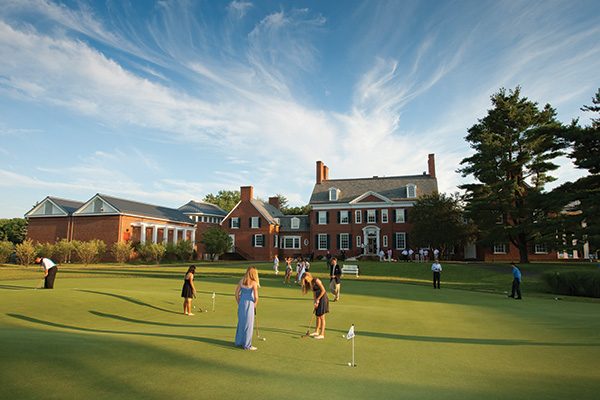
“It is almost impossible to remember how tragic a place the world is when one is playing golf,” Irish essayist Robert Lynd once wrote. For the golfer, a visit to the United States Golf Association Museum in Far Hills is almost as cathartic.
“We have the largest collection of golf artifacts in the world,” says museum curator Michael Trostel. What’s more, hands-on opportunities bring many of those artifacts to life.
Most of the displays tell the story of golf in the United States from the USGA’s founding in 1894 to the present. Notable items include golf balls made from shoe leather by American POWs during World War II; a putter used by President William Howard Taft (extra long to accommodate his prodigious girth); and the “moon club” used by astronaut Alan Shepard to hit golf balls on the lunar surface during the Apollo 14 mission in 1971.
The brick mansion that houses the museum was built in 1919 for New York financier Thomas Frothingham by John Russell Pope, who also designed the National Archives and Jefferson Memorial.
A tour begins in the Arnold Palmer room, which emphasizes Palmer’s special connection with his fans. A portrait comprised of 22,000 words either about or spoken by Palmer, painstakingly drawn by a fan, dominates the entryway. The Mickey Wright room details the mechanics of the near-perfect swing that ruled women’s golf in the 1960s (the sand wedge Wright used for her entire 15-year career has a sweet spot no bigger than a nickel). Other treasures are housed in the Bob Jones and Ben Hogan rooms. Construction will begin on the Jack Nicklaus room this summer.
In the Hall of Champions, the name of every USGA Championship winner is engraved on a wall plaque. “It’s always very touching when a champion comes here, takes out a piece of paper and a pencil or a crayon, and makes a rubbing of their name,” says Trostel.
A temporary exhibit, on display through 2013, chronicles barrier-breakers Jackie Robinson, Joe Louis and Althea Gibson. While better known for their achievements in baseball, boxing and tennis, respectively, each developed a love for golf—and an impressively low handicap—after their professional athletic careers.
Outside, visitors can try the Pynes Putting Course, a 16,000-square-foot, nine-hole green inspired by the Himalayas putting course at the St. Andrews Links in Scotland, revered as the birthplace of modern golf. Guests can sample replica putters, including Bob Jones’s Calamity Jane II and the controversial center-shafted Schenectady. You can even putt with bramble and square mesh golf balls from the turn of the 20th century.
The museum is also home to the USGA Research and Test Center, where the association ensures all clubs and balls used in its events meet its rigorous standards. Guests can also visit the USGA’s biomechanics lab. Tours tee off at 1 pm Tuesday to Friday. 77 Liberty Corner Road; 908-234-2300; usgamuseum.com.
Click here to read about more Springs Getaways.



